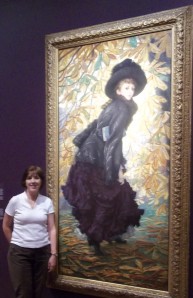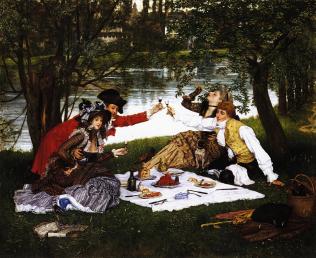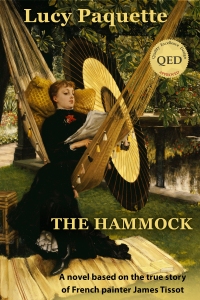To cite this article: Paquette, Lucy. “Tissot around the world: Canada,” The Hammock. https://thehammocknovel.wordpress.com/2013/06/10/tissot-around-the-world-canada/. <Date viewed.>
Canada’s art museums have some of James Tissot’s loveliest oil paintings, examples of his work ranging from his first successful years in Paris to his decade in London and his return to Paris.

Croquet (c. 1878), by James Tissot. 35.4 by 20 in. (89.8 by 50.8 cm). Art Gallery of Hamilton. (Photo: Wikipedia)
Croquet (c. 1878) is set in the impressive garden of Tissot’s house at 17 Grove End Avenue, St. John’s Wood. The picture is on view at the Art Gallery of Hamilton, Ontario, the gift of Dr. and Mrs. Basil Bowman in memory of their daughter, Suzanne, in 1965.

The Convalescent (A Girl in an Armchair, 1872), by James Tissot. Oil on panel, 14 ¾ by 18 in. (37.5 by 45.7 cm). Art Gallery of Ontario. (Photo: Wikiart.org)

Women in the Garden (1866), by Claude Monet. 100 by 81 in. (255 by 205 cm). Musée d’Orsay. (Photo: Wikimedia.org)
The Convalescent (1872, also called A Girl in an Armchair) was a gift to the Art Gallery of Ontario from R.B.F. Barr, Esq., Q.C., in 1966. This painting actually can be dated to 1870, meaning that Tissot painted it at his villa in Paris, in the conservatory. He moved into the elegant new house by late 1867 or early 1868, and he would end up leaving Paris altogether in the bloody aftermath of the radical Commune in May or June of 1871.
The style of the woman’s white morning gown, adorned with black scrollwork (soutache) embroidery – fashionable in the mid-1860s – is similar to that worn by the central figure in Monet’s monumental 1866 painting, Women in the Garden.

The Shop Girl (1883 – 1885), by James Tissot. 57.5 by 40 in. (146.1 by 101.6 cm). Art Gallery of Ontario. (Photo: Wikipedia)
The Shop Girl (1883 – 1885) was a gift to the Art Gallery of Ontario in Toronto, from the Corporations’ Subscription Fund, in 1968. This picture is one of Tissot’s series of large paintings, La Femme à Paris, portraying a cross-section of Parisian women.
The Letter (c. 1878), by James Tissot. 27 by 40 in. (68.58 by 101.60 cm). National Gallery of Canada, Ottawa, Ontario. (Photo: Wikimedia.org)
The Letter (c. 1878) is set in the Dutch Gardens of Holland House in London, perhaps depicting a quarrel between Lady Holland and her adopted daughter, Marie Liechtenstein. But why ruin the picture’s delightful ambiguity by searching too hard for specifics? From 1953 until her death, the painting belonged to The Hon. Mrs Nellie Ionides, née Samuel (1883–1962), eldest daughter of Shell Oil magnate Sir Marcus Samuel (later the 1st Viscount Bearsted), friend of Queen Mary, and a renowned London collector and connoisseur. It was sold with her estate in May 1963, at Sotheby’s, London to P. Claas (London) for $ 5,319/£ 1,900. In 1964, The Letter was purchased by New York art dealer James Coats, who sold it that year to the National Gallery of Canada in Ottawa, Ontario.

October (1877), by James Tissot. 85 by 42.8 in. (216 by 108.7 cm). Musée des Beaux-Arts de Montréal. (Photo: Wikiart.org)
 October (1877) was given to the Musée des Beaux-Arts de Montréal in Québec in 1927 by Scottish-born Canadian philanthropist Lord Strathcona (1820-1914) and his family.
October (1877) was given to the Musée des Beaux-Arts de Montréal in Québec in 1927 by Scottish-born Canadian philanthropist Lord Strathcona (1820-1914) and his family.
This monumental painting – over 7 feet tall and 3 ½ feet wide – is really charming. It depicts Tissot’s mistress and muse, Kathleen Newton (1854–1882) at age 23. In five years, she would die of tuberculosis, but in this moment, she is blooming, glowing amid the fall foliage.
I saw this last August, and you can almost hear Mrs. Newton’s petticoats rustling over her kitten heels. Tissot added life and depth to the space by painting a few deer behind her, to the left.

A Passing Storm (c. 1876), by James Tissot. 30.3 by 39.3 in. (76.84 by 99.7 cm). Beaverbrook Art Gallery, New Brunswick. (Photo: Wikipaintings.org)
In 1876, James Tissot brought Kathleen Newton to Ramsgate, a seaside resort on the Kent coast, seventy-eight miles southeast of London. A Passing Storm (c. 1876) is said to have been set in a room overlooking the harbour in Goldsmid Place (now Harbour Parade), but the model is not Mrs. Newton. A Passing Storm is in the collection of the Beaverbrook Art Gallery in Fredericton, New Brunswick, but it’s now part of an exhibition, called “Masterworks from the Beaverbrook Art Gallery,” booked in two U.S and four Canadian cities. The Beaverbrook has lent numerous items from its collection to exhibitions around the world, and A Passing Storm was displayed at the Society of the Four Arts in Palm Beach, Florida through the end of March. It will be on view at the Mobile Museum of Art in Mobile, Alabama, from December 5, 2013 through March 2, 2014, but then will return to Canada. You can see it at the Glenbow Museum in Calgary, Alberta from May-August, 2014; the Winnipeg Art Gallery, Manitoba from September-December, 2014; the National Gallery of Canada in Ottawa, Ontario in the summer of 2015; and The Rooms Provincial Art Gallery, St. John’s, Newfoundland in the summer of 2016. Additional venues may be announced.
With Canada’s Tissot oil paintings concentrated in Toronto, Ottawa and Montreal, it’s good news that A Passing Storm, at least, can be seen in so many different locations. It’s a great example of Tissot’s manner of permeating scenes with psychological tension.
© 2013 by Lucy Paquette. All rights reserved.
 UPDATE: In December, 2018, The National Gallery of Canada announced its acquisition of Tissot’s Partie Carrée (The Foursome, 1870), and the long-term loan from a private Canadian collection of Tissot’s The Japanese Scroll (c. 1872).
UPDATE: In December, 2018, The National Gallery of Canada announced its acquisition of Tissot’s Partie Carrée (The Foursome, 1870), and the long-term loan from a private Canadian collection of Tissot’s The Japanese Scroll (c. 1872).
The articles published on this blog are copyrighted by Lucy Paquette. An article or any portion of it may not be reproduced in any medium or transmitted in any form, electronic or mechanical, without the author’s permission. You are welcome to cite or quote from an article provided you give full acknowledgement to the author.
If you do not have a Kindle e-reader, you may download free Kindle reading apps for PCs, Smartphones, tablets, and the Kindle Cloud Reader to read The Hammock: A novel based on the true story of French painter James Tissot. Read reviews.
 The Hammock: A novel based on the true story of French painter James Tissot, brings Tissot’s world from 1870 to 1879 alive in a story of war, art, Society glamour, love, scandal, and tragedy.
The Hammock: A novel based on the true story of French painter James Tissot, brings Tissot’s world from 1870 to 1879 alive in a story of war, art, Society glamour, love, scandal, and tragedy.
Illustrated with 17 stunning, high-resolution fine art images in full color
Courtesy of The Bridgeman Art Library
(295 pages; ISBN (ePub): 978-0-615-68267-9). See http://www.amazon.com/dp/B009P5RYVE.
